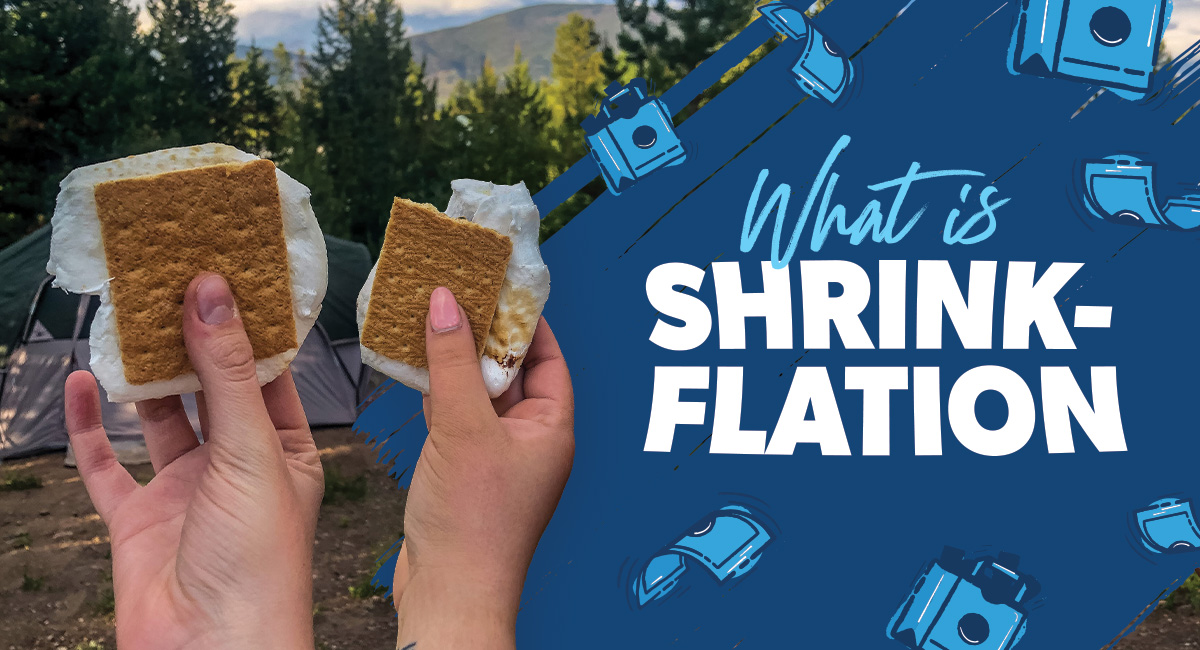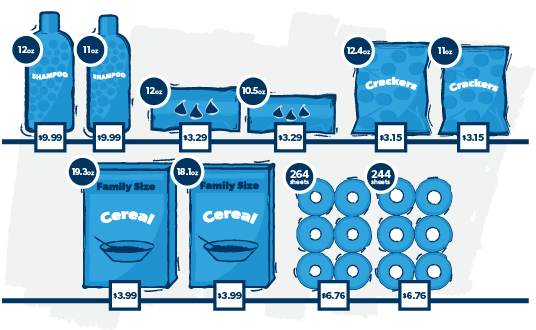Have you started to notice that items you used to buy are getting smaller? That bag of chocolate chips seems a tad lighter in your hands. You could swear those Little Debbie Oatmeal Creme Pies just aren’t as big as they used to be. And pouring yourself a bowl of cereal these days has you scratching your head and telling your spouse, “Honey, they shrunk the Kix.” No, you’re not going crazy—things are shrinking. Meet a little something called shrinkflation.
Yep, it’s true. There’s another ‘flation taking the world by storm. And this one might actually make people more freaking mad than inflation does ( . . . maybe). We’re talking about shrinkflation.
What Is Shrinkflation?
Shrinkflation is what happens when the items you buy shrink in size but you pay the same price for them. We’re talking forking over $5 for a half-gallon of ice cream—but you’re getting 0.8 ounces less of that creamy goodness. Paying $3.55 for that bag of candy—but getting 10 ounces instead of 12 ounces. And dropping $2.99 for boxed dessert snacks—only to find out they shrank down in size! (Yeah, we’re still not over that one.)
Makes sense, right? Shrinkflation just boils down to paying the same price for an item but getting less of it.
Is Shrinkflation the Same As Inflation?
The simple answer here is, shrinkflation isn’t the same thing as inflation—but they go hand in hand. When the costs go up for companies that produce products (thanks to inflation impacting the prices or the supply chain), they shrink the product to make up for the cost increase on their end. And that’s how shrinkflation is born.
As of October 2022, the Consumer Price Index, which measures the average price of goods and services, shows that the inflation rate in the U.S. had risen to 7.7% over the previous 12 months.1 With crazy record-high inflation rates, it’s no wonder that it’s costing businesses more money to make packaged items.
And while a lot of products out there cost more these days (like groceries), some companies have decided to shrink their product instead of raising prices (yep, you guessed it—that’s shrinkflation). The price for the food or goods goes up on the back end, but the consumer doesn’t see it. So you’re paying the same (maybe even more sometimes) but not getting as much product. Like inflation, the purchasing power of your dollar doesn’t go as far here—but for a different reason.
What Causes Shrinkflation?
Shrinkflation can happen when the materials or ingredients that companies use to make their products start costing more. So, instead of raising prices, they might just give you less of the product.
But do you want the bold truth? Shrinkflation is also caused by companies trying to keep their profits margins in place—aka they don’t want to lose a buck. Plain and simple. To make sure their bottom line is in shipshape, they decide to shrink down their products by just a smidge. The change is so under the radar that companies think they can keep their profits rolling in, all while the consumer is none the wiser.
Companies are smart enough to know that a price hike will probably catch a consumer’s eye, but a smaller bag or box? Not so much.
The moral of the story? Companies are cutting corners on the amount of bang you get for your buck and hoping you don’t notice.
Oh, but people are noticing.
In the last few months, social media has been chock-full of people sharing their photos of smaller portions. There’s even a full Reddit thread dedicated to shrinkflation.
Examples of Shrinkflation in Real Life
If you want to see shrinkflation in the wild for yourself, all you have to do is look around at the products you’re buying at the grocery store. But it’s hard to see unless you’re paying attention and comparing things. Still, once you start noticing it—it’s hard to stop seeing it.
Start budgeting with EveryDollar today!
Lately, people have called out companies like General Mills and Tillamook for letting shrinkflation impact their products. General Mills cut back on their family-size box of cereal, shrinking it from 19.3 ounces down to 18.1 ounces.2 But guess what? The two sizes cost the same price. Gasp. As for Tillamook, they decided to get out ahead of things and flat out own up to the fact that they shrank their ice cream from 56 ounces to 48 ounces.3
But shrinkflation doesn’t just stop with food products. Nope. Procter & Gamble made headlines for shrinkflation hitting their toilet paper. All of a sudden, they were rolling out 244 two-ply sheets down from 264 double-ply sheets.4 You can’t mess around with people’s toilet paper, man. Anyone remember the great TP shortage 2020? (Of course you do.)
- Shampoo bottle shrinks in size from 12.5 ounces to 11 ounces but still costs you $9.99.
- Chocolate chip bag goes from 12 ounces to 10.5 ounces but still costs you $3.29.
- Snack crackers go from 12.4 ounces to 11 ounces but still cost you $3.15.
- A box of family-size cereal goes from 19.3 ounces to 18.1 but costs you $3.99.
- A pack of toilet paper shrinks in width, and instead of getting 14 rolls, you now get 10.
What Is Skimpflation?
Nope, we didn’t spell shrinkflation wrong there. Skimpflation is a real thing too. Skimpflation is when you pay the same price for a product (with the same weight) but the bag has less in it. So maybe your cereal box didn’t change the actual ounces on the box, but they’re just flat out filling up the bag only one-third of the way with the marshmallow cereal you love so much. It’s shifty. It’s just plain rude. Think of skimpflation like shrinkflation’s evil twin.
What Can I Do About Shrinkflation?
Make protest signs and call your congressman and give them an earful about shrinkflation—just kidding! Even though you can’t do much to stop shrinkflation, you can try to stay one step ahead of it! Here’s how:
Read the labels.
A lot of folks already read the labels for health reasons (points for you!), but now there’s another reason to pay attention to the fine print—good old shrinkflation. See, if you don’t know how many ounces are in the products you normally buy, then you won’t notice a difference if they end up shrinking.
Buy generic items.
We’re fans of buying generic all the time, shrinkflation or not, but we especially love it as a way to fight shrinkflation. Your name-brand pasta sauce might be $4.99 for 16 ounces, but the generic brand is $3.99 for 20 ounces. Go for that one!
Hunt for sales.
We know, you’re probably already doing this. But be on the lookout for ways to get more of the products you need without costing you extra—aka keep your eyes peeled for sales. Buy one, get one free coffee grounds? Heck yes. Half off orange juice? Sign us up.
Look at cost per unit.
When you step back and take a look at how much each item costs you (that’s cost per unit), you might find it’s cheaper to buy in bulk. Especially if you have staple items you buy a lot (that won’t go bad too fast). Doing bulk buys might cost you a little more on the front end, but they can save you money when you look at the cost per unit (how much you’re paying per item). But that means you’re going to have to do some math. Get out your trusty calculator and crunch numbers like this:
Total item price ÷ unit weight or number = price per unit
(Example: $1.95 ÷ 12 eggs = 16 cents per egg)
Change the brands you buy.
As much as we might wish we could walk up to the Kellogg’s factory and tell them to stop shrinking down the box of our Special K cereal, it doesn’t really work that way. But what you can do is put your money where your mouth is—aka take your business somewhere else. If you’re sick and tired of shrinkflation from the brands you’re loyal to, here’s an idea: Start buying from other brands.
Make a budget.
Now that you know you’re not losing your mind by thinking everything around you is shrinking, it’s time to use your budget to tackle shrinkflation the same way you use it to combat inflation. Sure, you can’t control companies shrinking and skimping on your food—but you can take matters into your own hands and make sure your budget is ready for it.
The best way to stay on top of your budget is to actually make one (that’s pretty important). Having a monthly budget will help you make sure you don’t overspend and you do stick to your money goals. That’s because you’ll be telling your money where to go instead of wondering where it all went. You know, like the way you wonder where the cereal went in that bag that’s mostly air. Yeah, just like that. Our free budgeting app, EveryDollar, will get you ready to budget like a champ.




